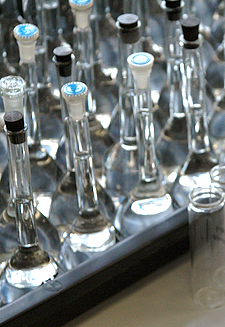Sebastian Hilscher

Tel. ++49 345 55 24887
email: sebastian.hilscher(at)pharmazie.uni-halle.de
Novel assay for histone deacetylases
HDAC10
Neuroblastoma is one of the most common childhood tumors and is a leading cause of cancer-related deaths in children. For the histone deacatylase isoform HDAC10, a correlation of expression levels with neuroblastoma diagnosis was found. HDAC10 plays a role in cell proliferation and cell migration as well as in angiogenesis and apoptosis. Since HDAC10 is also overexpressed in other cancers, such as lung or colon cancer, selective and potent inhibitors of HDAC10 are of great interest.
Currently, inhibitors of HDAC10 activity can only be analyzed with substrates that have KM values in the mid-millimolar range. Due to this assay limitation, characterization of high affinity inhibitors is difficult or impossible. Therefore, in addition to new HDAC10 inhibitors, we are also pursuing the development of new HDAC10 substrates for a continuous activity assay. We expect this to be a further step in inhibitor development, allowing us to better investigate the biological functions of HDAC10.
HDAC11
HDAC11 is the smallest and most recently discovered isoform of the HDAC family. Influences of HDAC11 activity on cell migration, cell growth and apoptosis have been shown. Furthermore, an association of increased HDAC11 activity with the development of obesity and its sequelae has also been demonstrated. HDAC11 is the only HDAC isoform that is catalytically nearly inactive against acetyl residues, but is very efficient at removing fatty acid residues from lysine side chains. This unique activity profile and the fact that HDAC11 is among the top 1 - 4% of genes overexpressed in several cancers (e.g. breast, colon, and hepatocellular carcinoma) make HDAC11 an interesting target for inhibitor research.
The inhibitors currently published for HDAC11 are mostly pan-HDAC inhibitors, i.e., non-selective. The selective inhibitors SIS17 and FT895 are either barely cell permeable and/or use a hydroxamic acid function to complex the Zn2+ ion. This functionality is pharmacologically suboptimal because of expected activity toward other zinc ion-dependent enzymes and their metabolic instability. Therefore, the development of potent and selective HDAC11 inhibitors with alternative zinc-binding groups is an exciting and ongoing area of research.





